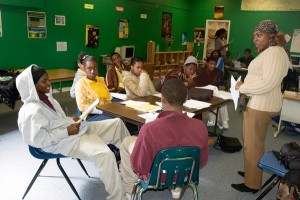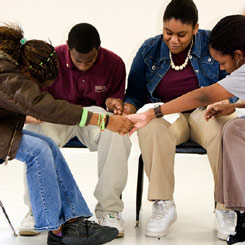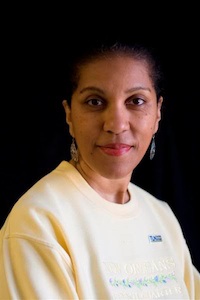We frequently hear of a “Digital Learning Gap” in connection with urban schools and urban poverty. Yet too often, consideration of the millions of students who live at or below the poverty line in rural areas never makes it into the headlines or discussion.
One of the American teachers I most respect — Renee Moore — can tell us something about rural. Several decades ago, Renee made the switch from Detroit-based freelance journalist to Mississippi Delta teacher and minister’s wife. She taught high school English along the rural Mississippi River for 17 years, during which time she earned National Board Certification, was named a Milken Educator, and was chosen as her adopted state’s 2001 Teacher of the Year. She was also named a Carnegie Scholar and ultimately became the first K12 teacher to serve on the board of the Carnegie Foundation for the Advancement of Teaching.
Renee is now an English instructor and faculty leader at Mississippi Delta Community College. She’s also a member of the Board of Directors of the National Board for Professional Teaching Standards and serves on Mississippi’s Commission on Teacher and Administrator Education, Certification, and Licensure. I’m proud to have recruited her as an early member of the Teacher Leaders Network (TLN). Most recently she joined 11 other TLN members in co-authoring a new vision for K12 teaching in America, Teaching 2030 (Teachers College Press, 2010). It’s an intriguing book that reflects on how best to strengthen the teaching profession to meet the needs of all 21st century students.
In this VOICES interview, I ask Renee to reflect on the state of “21st century learning” in the Delta, and to begin by describing conditions generally.
_____________
As a backdrop, can you talk some about the communities of the Mississippi Delta today — social and economic conditions, race relations, access to modern services?
I’m sharing some links with you on this point because my words alone probably can’t do justice to explaining the complexity or the disparity of conditions in the Delta. For example, this piece at YouTube on Poverty in Mississippi – The Untold Story (you can see other clips from the series at the right). It’s reminiscent of what the Kennedy Administration found in Mississippi during the early 60s. This type of abject poverty still exists around us here. According to Kids Count (2010), 33% of Mississippi’s children are living in poverty. Ironically, as unemployment grips the Delta, the overall state economy grew in 2010 by 1.7% — partly because manufacturers, such as Toyota, continued to be wooed to Mississippi by low wages and huge tax breaks (the corporate tax rate here is about 1/3 of that for individuals).
As for race relations, there are mixed signals. Among the young people, the lines between the races have become increasingly blurred in some ways. However, here in the town where I live and first started teaching (Cleveland, MS), we are still fighting over whether Brown vs. Board of Education is truly the law of the land. Cleveland is one of the few towns in the Delta (possibly the only one) that still has any significant number of white students in its public schools. However, members of the school board representing the white community have made it clear that if the district is forced to merge schools (particularly the middle and high schools), there will be major white flight to the private academy.
While some upgrades have come in human services, overall the Delta still has too few doctors and medical providers for its population. A recent Los Angeles Times feature on a long-suffering rural health clinic in Tutwiler, MS summed it up well: “Mississippi has the highest poverty rate in the nation and some of the sickest people, with the country’s highest rate of heart disease and the second-highest rate of diabetes.” Here’s one final link to a well-done comprehensive report on social conditions in Mississippi (especially for children and minorities).
How would you characterize teaching and learning in the Delta’s public schools — the strengths and the problems from your perspective?
 Delta schools continue to have a mixed history of performance and access. Delta schools and districts are consistently among the lowest performing in the state on most measures (state tests, ACT scores, graduation rates, dropout rates). Yet sprinkled among them are some highly innovative and outstanding programs. For example, this one, in Sunflower County schools was featured on Edutopia. The state’s only charter school, and one of the highest performing schools in the state, is located in my town. In a district that is 68% African American, only 39% of the charter school’s students are black.
Delta schools continue to have a mixed history of performance and access. Delta schools and districts are consistently among the lowest performing in the state on most measures (state tests, ACT scores, graduation rates, dropout rates). Yet sprinkled among them are some highly innovative and outstanding programs. For example, this one, in Sunflower County schools was featured on Edutopia. The state’s only charter school, and one of the highest performing schools in the state, is located in my town. In a district that is 68% African American, only 39% of the charter school’s students are black.
Some of the finest teachers I know work (or have worked) here in the Delta. At the same time, this has been an area of chronic teacher shortage for decades. Schools here rely heavily on programs such as Teach For America, and several state approved alternate certification programs, to find staff for all its classrooms. Teacher and administrator turnover is high across the Delta. Many of the schools are on academic watch, several districts are currently under state takeover or just released from state control. In those districts particularly, but across the Delta in general, the professional development and curriculum emphasis remains on preparation for the state tests and the narrow use of the resulting data to prepare for even more testing.
We’ve heard a lot about “the digital gap” over the past decade — the idea that students in families without much technology or internet access are at a learning disadvantage. Some say that mobile technologies are narrowing that gap. What’s your impression?
Mixed. On the one hand, there is more mobile technology, but because of the poverty and the illiteracy, that expansion has not been the great leveler of opportunity that many had hoped. More people have cell phones, but not necessarily Internet access. Technology access for the students in our public schools ranges from the sublime to the ridiculous. For example, in high-poverty Sunflower County, there is an elementary school with a state-of-the-art lab full of iMacs–that no one knew how to use until the school happened to get a TFA member assigned to them who owned an iMac personally. She was put in charge of the lab.
Many of the school districts have long outgrown their T1 lines and are unable to run their software, or most of their computers — at least not all at the same time. Many others have outdated hardware and software. There might be one or two Smartboards in a school building; there may or may not be accompanying software or someone who knows how to use it.
 Worst of all, too many schools are using what computers and Internet access they do have to provide computer-assisted remediation drills for students in preparation for their state tests. Teacher comfort and skill levels with technology vary widely. Last school year, a program was launched to send tech-savvy young college students into the Delta schools to help teachers learn how to make better use of whatever technology their school might have. But the concept of “connected learning” — helping students in our rural public school classrooms reach out to the larger world via technology — that’s still the exception, whether due to a lack of equipment, connectivity, professional development, or sometimes, just the missing spark of inspiration.
Worst of all, too many schools are using what computers and Internet access they do have to provide computer-assisted remediation drills for students in preparation for their state tests. Teacher comfort and skill levels with technology vary widely. Last school year, a program was launched to send tech-savvy young college students into the Delta schools to help teachers learn how to make better use of whatever technology their school might have. But the concept of “connected learning” — helping students in our rural public school classrooms reach out to the larger world via technology — that’s still the exception, whether due to a lack of equipment, connectivity, professional development, or sometimes, just the missing spark of inspiration.
How well integrated is technology and the Internet into daily instruction in Delta schools? How about at the community college level, where you teach now?
I’ve touched on that a little above. The degree of integration varies greatly at the PK-12 level. At Mississippi Delta Community College, which serves seven counties here in the heart of the Delta, we make fairly extensive use of the Blackboard learning system, so all of our classes are either hybrid or fully online. The learning curve for our students has been steep, since many of them come to us without even basic computer skills. But then, the learning curve for the faculty is pretty steep, too.
Most of the instruction that teachers get on using Blackboard and other tech tools in classroom is informal sharing among the faculty rather than systematic professional development. I’ve enjoyed watching several of my colleagues make a lie of the myth that veteran teachers are resistant to technology and newer millennial instructors are all born tech confident.
Still, we have our equipment and access issues as well. On the one hand, we have a plethora of computer labs, wireless in the dorms, but no internet access in the classrooms of our main classroom building. Our English faculty have gotten pretty adept at using programs such as the Turnitin anti-plagiarism site, and the increasingly popular SmartThinking online tutoring service for students. We’ve been slower to embrace student blogging, wikis, teaching with social media tools, or persistent online interactions among teachers.
My sense in both K12 and higher ed is that we are still not getting anywhere near the full potential of the technology we have — primarily because the teachers have not gotten fully comfortable with how to integrate it effectively into their teaching. In our College, for example, within the Blackboard system we have the capability to do blogs, online journals, e-portfolios, podcasts, voice email, wikis, and more. Yet most instructors still just use it for posting copies of their lecture notes and tests.
If you were advising federal and state leaders on how to address rural poverty and education issues in your community and elsewhere, what would your 4-5 top strategic recommendations be?
 1. Support and expand the effort to bring affordable broadband access to more of the rural South.
1. Support and expand the effort to bring affordable broadband access to more of the rural South.
2. Re-open and re-staff public and school libraries which are a major source of web access for Delta residents and rural residents generally.
3. Strengthen and expand requirements that schools and districts who receive technology grants dedicate sufficient resources and time for job embedded professional development on how to best integrate the use of these technologies with their teaching for improved student learning.
4. More closely monitor districts for equitable distribution of technology funds and resources among schools.
5. Encourage the formation of and provide support for effective teacher networks (local and virtual) to promote professional learning.
It’s been more than 40 years since the United States began its first serious effort to dismantle the separate and seldom-if-ever equal school systems that were tarnishing our democracy. We’re not there yet, and we need to finish what we started. Our students, wherever they are, and whatever their personal circumstances may be, won’t have a chance to succeed in this Digital Age unless we can guarantee every public school the same resources, the same support, and the same excellent teaching force.
How can our readers keep up with your commentaries on these and other issues?
I blog at TeachMoore (twitter: @teachmoore). You can look up my digital footprint on Google to find other articles and commentaries. And consider reading Teaching 2030. You’ll hear my voice and the voices of many other committed teachers in that provocative book.
I think I captured some of my personal perspective about the urgency to pursue 21st century learning in my part of the world in a 2010 blog post I called Dear Angela. It’s written to a friend of mine who was an excellent teacher and became an elementary principal not long ago. It’s a frank appraisal of unrealized potential in one school I know well.
John Norton
Latest posts by John Norton (see all)
- I'm a "Learner First" in a Whole New World - July 1, 2013
- Hale@home: Easing Student Transitions via Online Learning - May 17, 2013
- Our Top 13 Voices Posts for 2012! - January 1, 2013



Do we know what makes a good teacher? In a new blog post at her TeachMoore blog, Renee Moore points to research-based professional teaching standards — and 15 years of application of those standards to certify nearly 100,000 teachers — and says: Yes we do.
http://teacherleaders.typepad.com/teachmoore/2011/10/how-good-teaching-looks-1.html
Renee,
I think your idea
3. Strengthen and expand requirements that schools and districts who receive technology grants dedicate sufficient resources and time for job embedded professional development on how to best integrate the use of these technologies with their teaching for improved student learning.
is right on!!! I’ve always been a huge proponent of investing as least as many dollars in training and at least as many dollars in maintaining digital resources as we do in buying the hardware. So many schools have the exact problem that it sounds like the Delta schools have….they believe that getting the “stuff” will magically integrate the tools into the classroom.
We all need more of the pie invested in training and maintenance.
Would we be willing to settle for fewer resources that came with better training and support? I guess that’s the question all of us will need to answer in these days of limited and dwindling financial resources. What do you think?